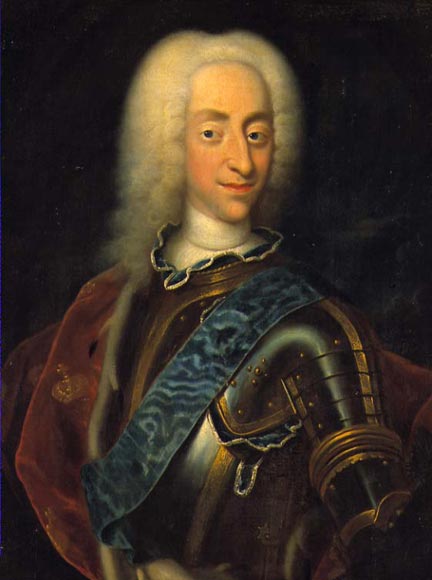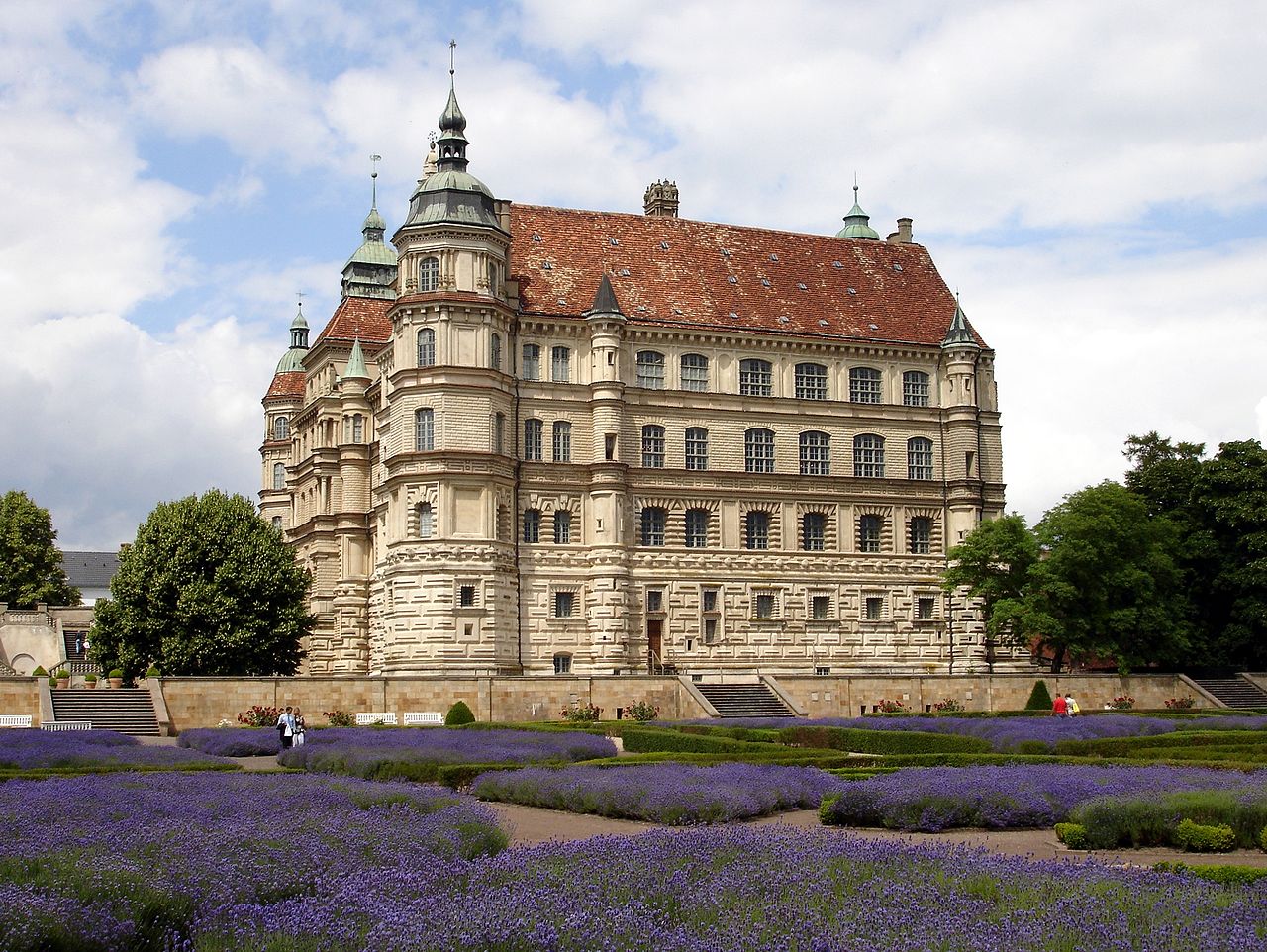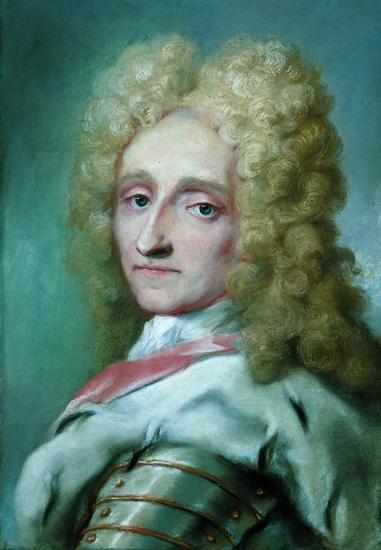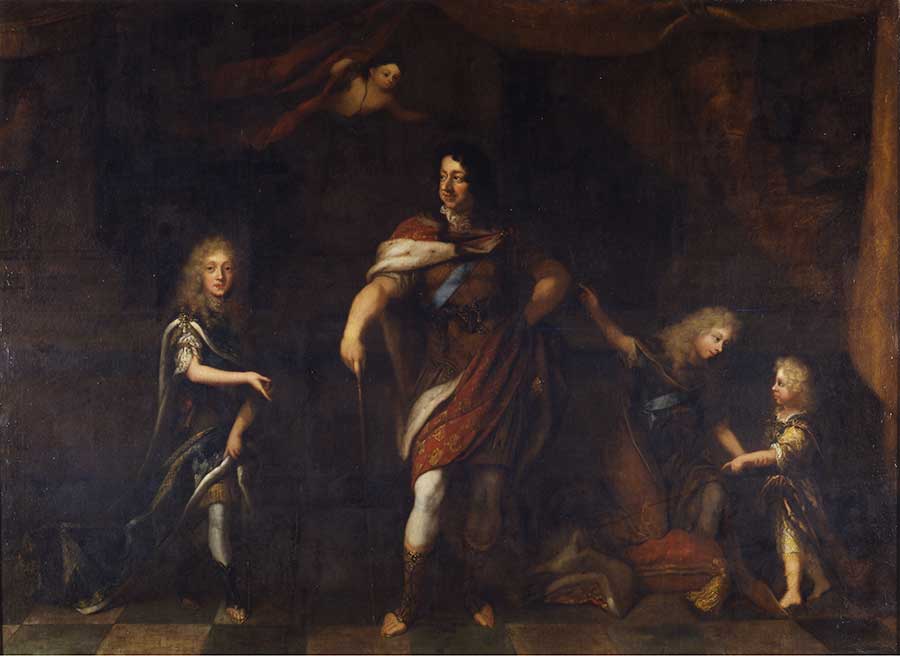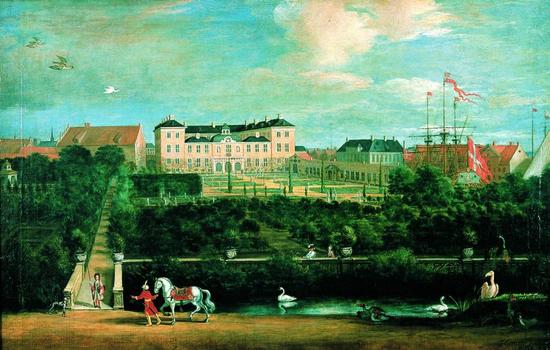compiled by Susan Flantzer
© Unofficial Royalty 2020
Smallpox is an infectious disease caused by a virus. The initial symptoms of the disease included fever and vomiting. This was followed by the formation of sores in the mouth and a skin rash. The skin rash turned into fluid-filled bumps with a dent in the center. The bumps then scabbed over and fell off, leaving scars
Smallpox, now eradicated, was a serious contagious disease that killed many and left many survivors scarred. The disease knew no class boundaries and royalty was as likely to suffer from it as the common folk. Smallpox was a leading cause of death in the 18th century. It killed an estimated 400,000 Europeans each year in the 18th century.
A number of sovereigns died from smallpox including (in death order): Willem II, Prince of Orange; Johann Georg IV, Elector of Saxony; Queen Mary II of England; Emperor Higashiyama of Japan; Joseph I, Holy Roman Emperor; King Luis I of Spain; Peter II, Emperor of All Russia; Louise Hippolyte, Sovereign Princess of Monaco; Ulrika Eleonora, Queen of Sweden; King Louis XV of France; and Maximilian III Joseph, Elector of Bavaria.
Many royal children also succumbed to smallpox. King Ferdinand IV of Naples and Sicily and Maria Carolina of Austria lost seven children to smallpox.
King William III of England, born Willem III, Prince of Orange, who reigned England jointly with his first cousin and wife Queen Mary II following the Glorious Revolution of 1688 in which Mary’s father and William’s uncle King James II was deposed, has a particularly sad smallpox history. William was born eight days after his father Willem II, Prince of Orange died from smallpox. His mother Mary, Princess Royal, Princess of Orange died from smallpox when William was ten-years-old. William’s wife Queen Mary II also died from smallpox.
Before Edward Jenner developed the smallpox vaccine that contained the cowpox virus in 1796 and that ultimately lead to the eradication of smallpox, there was another way to possibly prevent smallpox called variolation and it was first seen in China in the fifteenth century. In 1716, Lady Mary Wortley Montagu accompanied her husband to Turkey where he was to serve as the British ambassador. While she was in Turkey, Lady Mary observed the Turkish practice of smallpox variolation or inoculation. Live smallpox virus in the liquid taken from a smallpox blister in a mild case of the disease was put into a cut of a healthy person.
After the inoculation, Lady Mary observed that those inoculated “are well for eight days. Then the fever seizes them and they keep their beds two days seldom three. They have rarely more than twenty or thirty pustules on their face, which leave no mark, and then they are as well as before their inoculation.” However, there was some risk using a live virus. About 3% of those inoculated developed serious smallpox and died. Others spent weeks recovering, but that was preferable to catching smallpox with its mortality rate of 20–40% and scarred survivors.
When she returned to England, Lady Mary persuaded Caroline, Princess of Wales (wife of the future King George II) to arrange to have the inoculation tested using prisoners and orphans, all of whom survived the inoculation. In 1722, King George I allowed two of his grandchildren, the children of the Prince and Princess of Wales, to be inoculated, and they survived. The inoculation gained acceptance and was used until Edward Jenner developed his much safer vaccination using the cowpox virus instead of the smallpox virus.
This does not purport to be a complete list. All images are from Wikipedia unless otherwise indicated.
********************
Franz Otto, Duke of Brunswick-Lüneburg

- Born: June 20, 1530
- Parents: Ernst I, Duke of Brunswick-Luneburg and Sophie from Mecklenburg-Schwerin
- Married: Elisabeth Magdalene of Brandenburg in 1559
- Died: April 29, 1559, aged 28
- Buried: Stadtkirche St. Marien in Celle, Duchy of Brunswick-Lüneburg, now in Lower Saxony, Germany
- Wikipedia: Franz Otto, Duke of Brunswick-Lüneburg
Franz Otto died from smallpox shortly after his marriage
********************
Aleksander Karol Vasa of Poland

- Born: November 14, 1614, in Warsaw, Polish-Lithuanian Commonwealth, now in Poland
- Parents: King Sigismund III Vasa of Poland, Grand Duke of Lithuania and Constance of Austria
- Died: November 19, 1634, aged 20, in Wielkie, Polish-Lithuanian Commonwealth, now in Poland
- Buried: Krakow in Polish-Lithuanian Commonwealth, now in Poland
- Wikipedia: Aleksander Karol Vasa of Poland
Aleksander caught smallpox from his elder brother Jan Kazimierz Vasa who survived.
********************
Baltasar Carlos of Spain, Prince of Asturias

- Born: October 17, 1629 at the Royal Alcázar in Madrid, Spain
- Parents: King Felipe IV of Spain and Elisabeth of France
- Died: October 9, 1646, aged 16, in Zaragoza, Spain
- Buried: Monastery of San Lorenzo de El Escorial in El Escorial, Spain
- Wikipedia: Baltasar Carlos, Prince of Asturias
Baltasar Carlos was his parents’ only son and the heir to the throne of Spain. On October 5, 1629, the eve of the second anniversary of his mother’s death, Baltasar Carlos and his father attended vespers in her memory. The next day, Baltasar Carlos was too ill to attend his mother’s memorial mass. The disease, smallpox, spread quickly and he was given the Last Rites on October 9, 1629. Baltasar Carlos died that evening.
********************
Willem II, Prince of Orange

- Born: May 27, 1626, in The Hague, Dutch Republic, now in the Netherlands
- Parents: Frederik Hendrik, Prince of Orange and Amalia of Solms-Braunfels
- Married: Mary, Princess Royal, eldest daughter of King Charles I of England, in 1641
- Died: November 6, 1650, aged 24, in The Hague, Dutch Republic, now in the Netherlands
- Buried: Nieuwe Kerk in Delft, Dutch Republic, now in the Netherlands
- Unofficial Royalty: Willem II, Prince of Orange
Willem II fell ill with smallpox while his wife Mary was pregnant with her first child. Eight days after Willem’s death, Mary gave birth to her only child Willem III, Prince of Orange who went on to marry his first cousin Mary, the eldest surviving child of the future King James II of England. Following the Glorious Revolution of 1688 in which James II was deposed, they jointly reigned as King William III and Queen Mary II. Sadly, William III’s mother and wife also died from smallpox.
********************
Prince Henry of England, Duke of Gloucester

- Born: July 8, 1640 at Oatlands Palace in Surrey, England
- Parents: King Charles I of England and Henrietta Maria of France
- Died: September 13, 1660, aged 20, at the Palace of Whitehall in London, England
- Buried: Westminster Abbey in London, England
- Wikipedia: Prince Henry, Duke of Gloucester
In 1660, when the monarchy was restored in England, Henry accompanied his eldest brother King Charles II back to their homeland. In early September 1660, a smallpox epidemic was raging in London and Henry contracted the disease and died. Two months after Henry’s death, his sister Mary, Princess Royal and Princess of Orange, who was visiting London, also died from smallpox.
********************
Mary, Princess Royal and Princess of Orange

- Born: November 4, 1631 at St. James Palace in London, England
- Parents: King Charles I of England and Henrietta Maria of France
- Married: Willem II, Prince of Orange in 1641
- Died: December 24, 1660, aged 29, at the Palace of Whitehall in London, England
- Buried: Westminster Abbey in London, England
- Unofficial Royalty: Mary, Princess Royal and Princess of Orange
In May 1660, Mary watched as her brothers Charles, James, and Henry sail away from The Hague in the Dutch Republic (now the Netherlands) returning to England upon the restoration to the throne of Charles (King Charles II). Mary returned to her birth country in September 1660. Although the court was in mourning for her brother Henry, Duke of Gloucester who had died of smallpox, her brothers Charles and James traveled down the River Thames to meet her.
Sadly, Mary did not have much time to celebrate her brother’s restoration. On December 20, 1660, Mary fell ill with smallpox, and by the next day she was dangerously ill. Mary died four days later. Her son William was just ten years old and had lost both parents to smallpox. William’s wife and co-ruler Queen Mary II would also die of smallpox.
********************
Louis-Armand of Bourbon, Prince of Conti

- Born: April 30, 1661 at the Hôtel de Conti in Paris, France
- Parents: Armand of Bourbon, Prince of Conti and Anne Marie Martinozzi
- Married: Marie Anne of Bourbon, illegitimate daughter of King Louis XIV of France and his mistress Louise de La Vallière, in 1680
- Died: November 9, 1685, aged 24, at the Palace of Fontainebleau in Seine-et-Marne, France
- Buried: Conti Mausoleum at St. Thomas of Canterbury Church in Vallery, France
- Wikipedia: Louis-Armand of Bourbon, Prince of Conti
Louis-Armand’s wife was ill with smallpox and he then contracted the disease. While his wife survived, Louis-Armand died five days later.
********************
Infanta Isabel Luísa of Portugal, Princess of Beira

- Born: January 6, 1669 at Ribeira Palace in Lisbon, Portugal
- Parents: King Pedro II of Portugal and Maria Francisca of Savoy
- Died: October 22, 1690, aged 21, at Palhavã Palace in Lisbon, Portugal
- Buried: Monastery of São Vicente de Fora in Lisbon, Portugal
- Wikipedia: Infanta Isabel Luísa of Portugal, Princess of Beira
Isabel Luísa was the heir presumptive to the throne of Portugal between 1668 and 1689, when her half-brother, the future King João V was born. During that period, she was styled Princess of Beira. She died from smallpox the year after her half-brother was born.
********************
Johann Georg IV, Elector of Saxony

- Born: October 18, 1668 in Dresden, Electorate of Saxony, now in Saxony, Germany
- Parents: Johann Georg III, Elector of Saxony and Anna Sophie of Denmark
- Married: Eleonore Erdmuthe of Saxe-Eisenach in 1692
- Died: April 27, 1694, aged 25, in Dresden, Electorate of Saxony, now in Saxony, Germany
- Buried: Freiberg Cathedral in Freiberg, Electorate of Saxony, now in Saxony, Germany
- Wikipedia: Johann Georg IV, Elector of Saxony
Magdalena Sibylla of Neidschutz, Johann Georg’s mistress, died from smallpox, in his arms. Johann Georg caught smallpox from Magdalena Sibylla and died 23 days later.
********************
Queen Mary II of England

- Born: April 30, 1662 at St. James’ Palace in London, England
- Parents: James, Duke of York (the future King James II of England) and his first wife Anne Hyde
- Married: Willem III, Prince of Orange, the future King William III of England in 1677
- Died: December 28, 1694, aged 32, at Kensington Palace in London, England
- Buried: Westminster Abbey in London, England
- Unofficial Royalty: Queen Mary II of England
Following the Glorious Revolution of 1688 in which Mary’s father King James II of England was deposed, Mary and her husband jointly reigned as King William III and Queen Mary II. Mary’s husband William was her first cousin, the only child of her paternal aunt Mary, Princess of Wales. William was third in the line of succession to the English throne after Mary and her sister Anne (the future Queen Anne).
In December 1694, smallpox was spreading through London and Mary contracted the disease. The first thing Mary did was to send away everyone who had not had smallpox. Her husband William, who had survived the disease, had a bed put in Mary’s room and oversaw her medical care. On the evening of Christmas Day 1694, Mary’s condition worsened and the doctors told her she would die. On December 27, 1694, Mary lapsed into unconsciousness. In the early morning of December 28, 1694, Mary peacefully died. William was terribly grief-stricken, collapsed at Mary’s bedside, and had to be carried, nearly insensible, from the room. William had lost both his parents and his wife to smallpox.
********************
Prince Christian of Denmark

- Born: March 25, 1675 at Copenhagen Castle in Copenhagen, Denmark
- Parents: King Christian V of Denmark and Charlotte Amalie of Hesse-Kassel
- Died: June 27, 1695, aged 20, in the Free Imperial City of Ulm, now in Baden-Württemberg, Germany
- Buried: Roskilde Cathedral in Roskilde, Denmark
- Wikipedia: Prince Christian of Denmark
While on his first major trip outside of Denmark, to Italy, Christian contracted smallpox. He was taken to Ulm where he died.
********************
Archduchess Maria Theresa of Austria
- Born: August 22, 1684 at Hofburg Palace in Vienna, Austria
- Parents: Leopold I, Holy Roman Emperor and Eleonore Magdalene of Neuberg
- Died: September 28, 1696, aged 12 at Palais Ebersdorf in Vienna, Austria
- Buried: Imperial Crypt at the Capuchin Church in Vienna, Austria
- Wikipedia: Archduchess Maria Theresa of Austria
Her younger sister Maria Josepha died from smallpox seven years later.
********************
Archduchess Maria Josepha of Austria

- Born: March 6, 1687 at Hofburg Palace in Vienna, Austria
- Parents: Leopold I, Holy Roman Emperor and Eleonore Magdalene of Neuberg
- Died: April 14, 1703, aged 16, in Vienna, Austria
- Buried: Imperial Crypt at the Capuchin Church in Vienna, Austria
- Wikipedia: Archduchess Maria Josepha of Austria
Her elder sister Maria Theresa died from smallpox seven years earlier.
********************
Prince Christian Karl of Schleswig-Holstein-Sonderburg-Plön-Norburg
- Born: August 20, 1674 in Magdeburg, Electorate of Brandenburg, now in Saxony-Anhalt, Germany
- Parents: August, Duke of Schleswig-Holstein-Sonderburg-Plön-Norburg and Elisabeth Charlotte of Anhalt-Harzgerode
- Married: Dorothea Christina of Aichelberg in 1702
- Died: May 23, 1706, aged 31, in Sonderburg, Duchy of Schleswig, now in Denmark
- Buried: Royal Crypt in Plön, Duchy of Schleswig-Holstein-Sonderburg-Plön, now in Schleswig-Holstein, Germany
- Wikipedia: Prince Christian Karl of Schleswig-Holstein-Sonderburg-Plön-Norburg
Christian Karl was an officer in the Brandenburg-Prussian army. He died from smallpox.
********************
Emperor Higashiyama of Japan

- Born: October 21, 1675
- Parents: Emperor Reigen of Japan and Matsuki Muneko
- Married: Princess Yukiko
- Died: January 16, 1710, aged 34
- Buried: Moon Ring Tomb in Kyoto, Japan
- Wikipedia: Emperor Higashiyama of Japan
The two leaders of Japan, Shogun Tokugawa Tsunayoshi and Emperor Higashiyama, both died of smallpox in the same year.
********************
Louis of France, Le Grand Dauphin

- Born: November 1, 1661, at the Château de Fontainebleau in Fontainebleau, Seine-et-Marne, France
- Parents: King Louis XIV of France and Maria Theresa of Spain
- Married: Maria Anna Victoria of Bavaria in 1680
- Died: April 14, 1711, aged 49, at the Château de Meudon in Meudon, Hauts-de-Seine, France
- Buried: Basilica of Saint-Denis outside Paris, France
- Unofficial Royalty: Louis of France, Le Grand Dauphin
Louis was the only surviving legitimate son of King Louis XIV of France. In the spring of 1711, Louis caught smallpox, apparently from a priest who was distributing Holy Communion after he had visited a smallpox victim. As Louis had always been healthy and robust, his illness shocked the people of France, the French court, and the royal family.
********************
Joseph I, Holy Roman Emperor
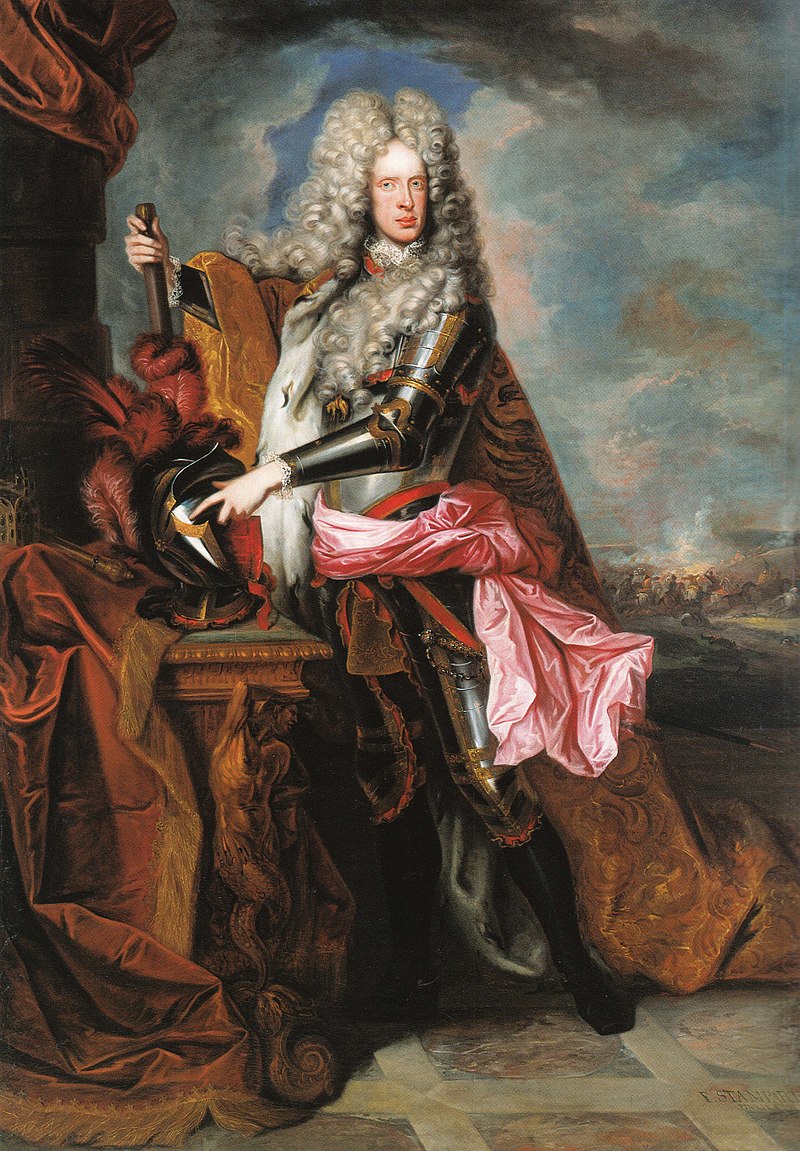
- Born: July 26, 1678 in Vienna, Austria
- Parents: Leopold I, Holy Roman Emperor and Eleonore Magdalena of Neuburg
- Married: Wilhelmine Amalia of Brunswick-Lüneburg in 1699
- Died: April 17, 1711, aged 32, in Vienna, Austria
- Buried: Imperial Crypt at the Capuchin Church in Vienna, Austria
- Wikipedia: Joseph I, Holy Roman Emperor
Joseph had two sisters who both died from smallpox: Archduchess Maria Theresa of Austria in 1696 and Archduchess Maria Josepha of Austria in 1703. In the spring of 1711, a smallpox epidemic reached Austria and Joseph succumbed to smallpox. He had promised his wife to stop having affairs if he survived.
********************
Princess Élisabeth Charlotte of Lorraine, Hereditary Prince Louis of Lorraine, and Princess Marie Gabrièle Charlotte
 Louis, Hereditary Prince of Lorraine
Louis, Hereditary Prince of Lorraine
- Born: Élisabeth Charlotte on October 21, 1700 at the Ducal Palace of Nancy in the Duchy of Lorraine, now in France; Marie Gabrièle Charlotte on December, 30, 1702; Louis on January 28, 1704 at the Château de Lunéville in the Duchy of Lorraine, now in France
- Parents: Leopold, Duke of Lorraine and Élisabeth Charlotte d’Orléans
- Died: Élisabeth Charlotte on May 4, 1711, aged 10; Louis on May 10, 1711, aged 7; Marie Gabrièle Charlotte on May 11, 1711, aged 8; all died at the Château de Lunéville in the Duchy of Lorraine, now in France
- Buried: Ducal Crypt at the Église Saint-François-des-Cordeliers in Nancy, Duchy of Lorraine, now in France
- Wikipedia: Princess Élisabeth Charlotte of Lorraine
- Wikipedia: Louis, Hereditary Prince of Lorraine
The smallpox epidemic of 1711 had already killed Louis of France, Le Grand Dauphin, heir to the French throne, and Joseph I, Holy Roman Emperor and now it struck the household of Leopold, Duke of Lorraine. Élisabeth Charlotte developed smallpox and passed it on to her sister Marie Gabrièle Charlotte and brother Louis, Hereditary Prince of Lorraine. All three children died within a week of each other. When Louis died, his younger brother Léopold Clement Charles became Hereditary Prince, but he too died of smallpox in 1723. (See below.)
********************
Louisa Maria Stuart

- Born: June 28, 1692, at the Château of Saint-Germain-en-Laye in Saint-Germain-en-Laye, France
- Parents: the deposed King James II of England and his second wife Maria Beatrice of Modena
- Died: April 18, 1712, aged, at the Château of Saint-Germain-en-Laye in Saint-Germain-en-Laye, France
- Buried: Chapel of Saint Edmund in the Church of the English Benedictines in the Rue St. Jacques in Paris, France which was destroyed during the French Revolution. Some remains were discovered after the French Revolution and reburied in 1824 at the Parish Church of Saint-Germain-en-Laye.
- Unofficial Royalty: Louisa Maria Stuart
In 1688, Louisa Maria’s Catholic father was overthrown during the Glorious Revolution in favor of his Protestant daughter Queen Mary II from his first marriage and her husband and paternal first cousin William III, Prince of Orange who reigned jointly with his wife as King William III. King Louis XIV of France, her father’s first cousin, provided the Chtâeau of Saint-Germain-en-Laye as a residence for exiled James II and his family. In April 1712, Louisa Maria and her brother James Francis Edward both fell ill with smallpox. Her brother recovered, but Louisa’s condition became steadily worse and she died.
********************
Charles Joseph of Lorraine, Archbishop and Prince Elector of Trier

Charles Joseph died from smallpox while on a visit to Vienna.
********************
Vittorio Amedeo of Savoy, Prince of Piedmont

- Born: May 6, 1699 at the Royal Palace of Turin in Turin, Duchy of Savoy, now in Italy
- Parents: Vittorio Amedeo II, Duke of Savoy and Anne Marie d’Orléans
- Died: March 22, 1715, aged 15, at the Royal Palace of Turin in Turin, Duchy of Savoy, now in Italy
- Buried: Royal Basilica of Superga in Turin, Duchy of Savoy, now in Italy
- Wikipedia: Vittorio Amedeo of Savoy, Prince of Piedmont
Vittorio Amedeo, the heir to the throne of Savoy, died from smallpox.
********************
Léopold Clément, Hereditary Prince of Lorraine

- Born: 25 April 25, 1707 at the Château de Lunéville in the Duchy of Lorraine, now in France
- Parents: Leopold, Duke of Lorraine and Élisabeth Charlotte d’Orléans
- Died: June 4, 1723, aged 16, at the Château de Lunéville in the Duchy of Lorraine, now in France
- Buried: Ducal Crypt at the Église Saint-François-des-Cordeliers in Nancy, Duchy of Lorraine, now in France
- Wikipedia: Léopold Clément, Hereditary Prince of Lorraine
In May 1711, three of Léopold Clément’s siblings died from smallpox including his elder brother Louis, Hereditary Prince of Lorraine. Léopold Clément became the Hereditary Prince of Lorraine upon his brother’s death. As he was preparing for a trip to Vienna, Léopold Clément became ill with smallpox and quickly died. His younger brother François Étienne became the Hereditary Prince of Lorraine and succeeded his father as Duke of Lorraine. François Étienne, better known as Franz, married Maria Theresa, the Habsburg heiress and future Queen Regnant of Hungary and Bohemia and was elected Holy Roman Emperor in 1745.
********************
King Luis I of Spain
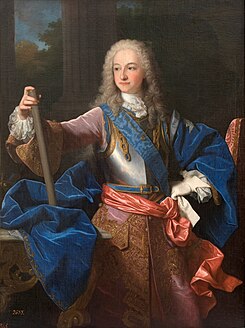
- Born: August 25, 1707 at the Palacio del Buen Retiro in Madrid, Spain
- Parents: King Felipe V of Spain and Maria Luisa of Savoy
- Married: Louise Élisabeth d’Orléans in 1722
- Died: August 31, 1724, aged 17, at the Palacio del Buen Retiro in Madrid, Spain
- Buried: Royal Crypt of the Monastery of El Escorial in El Escorial, Spain
- Wikipedia: King Luis I of Spain
In August 1724, Luis contracted smallpox. His 15-year-old wife took care of him and remained with him until his death, months after he ascended the throne. Louise Élisabeth also contracted smallpox but she recovered.
********************
Peter II, Emperor of All Russia

- Born: October 23, 1715 in St. Petersburg, Russia
- Parents: Tsarevich Alexei Petrovich and Charlotte Christine of Brunswick-Lüneburg
- Died: January 30, 1730, aged 14, in Moscow, Russia
- Buried: Cathedral of the Archangel in the Moscow Kremlin in Moscow, Russia
- Unofficial Royalty: Peter II, Emperor of All Russia
Peter II was the grandson of Peter I (the Great), Emperor of All Russia. On January 17, 1730, a frigid day, Peter II attended a parade. When he returned to the palace, he had a fever that developed into smallpox. On January 30, 1730, which was supposed to be his wedding day, the delirious Peter ordered his sleigh to be readied so he could go see his sister Natalia, forgetting that she had died a little more than a year earlier. Peter died a few minutes later.
********************
Louise Hippolyte, Sovereign Princess of Monaco

- Born: November 10, 1697 at the Prince’s Palace in Monaco
- Parents: Antonio I, Prince of Monaco and Marie de Lorraine-Armagnac
- Married: Jacques François Goyon, Count de Matignon, (Jacques I, Prince of Monaco 1731-1733) in 1715
- Died: December 29, 1731, aged 34, at the Prince’s Palace in Monaco
- Buried: St. Nicholas Cathedral in Monaco
- Wikipedia: Louise Hippolyte, Sovereign Princess of Monaco
When Louise Hippolyte died from smallpox on December 29, 1731, her husband became Sovereign Prince of Monaco. However, he neglected the affairs of Monaco and left for France in May 1732. The next year, he abdicated in favor of his thirteen-year-old son who reigned Honoré III.
********************
Philippine Élisabeth of Orléans, Mademoiselle de Beaujolais

- Born: December 18, 1714 at the Palace of Versailles in Versailles, France
- Parents: Philippe II, Duke of Orléans, Regent of France and Françoise-Marie de Bourbon
- Died: May 21, 1734, aged 19, at Château de Bagnolet in Bagnolet, France
- Buried: Church of the Val-de-Grâce in Paris, France
- Wikipedia: Philippine Élisabeth of Orléans
Philippine Élisabeth Charlotte was named after her paternal grandparents, Philippe I, Duke of Orléans (brother of King Louis XIV of France) and his second wife Elisabeth Charlotte of the Palatinate. Her mother was a legitimized daughter of King Louis XIV and his mistress Madame de Montespan. While living at her mother’s favorite residence, the Château de Bagnolet, she died of smallpox. Her sister Louise Adélaïde died from smallpox in 1743.
********************
Ulrika Eleonora, Queen of Sweden

- Born: January 23, 1688 at the Castle Tre Kronor in Stockholm, Sweden
- Parents: King Carl XI of Sweden and Ulrika Eleonora of Denmark
- Married: Friedrich of Hesse-Kassel, later King Frederik I of Sweden
- Died: November 24, 1741, aged 53, Wrangelian Palace in Stockholm, Sweden
- Buried: Ridderholmen Church in Stockholm, Sweden
- Unofficial Royalty: Ulrika Eleonora, Queen of Sweden
Ulrika Eleanora reigned as Queen of Sweden in her own right from 1718 until 1720 when she abdicated in favor of her husband. She was then Queen Consort of Sweden for the rest of her life. Ulrika Eleonora died of smallpox. There were rumors that she had been poisoned but these rumors were dispelled when the effects of smallpox were visible during her public lying-in-state.
********************
Louise Adélaïde of Orléans, Abbess of Chelles

- Born: August 13, 1698 at the Palace of Versailles in Versailles, France
- Parents: Philippe II, Duke of Orléans, Regent of France and Françoise-Marie de Bourbon
- Died: February 10, 1743, aged 44, at the Convent de la Madeleine de Traisnel in Paris, France
- Buried: Church of the Val-de-Grâce in Paris, France
- Wikipedia: Louise Adélaïde of Orléans, Abbess of Chelles
Louise Adélaïde’s father was the son of Philippe I, Duke of Orléans (brother of King Louis XIV of France) and his second wife Elisabeth Charlotte of the Palatinate. Her mother was a legitimized daughter of King Louis XIV and his mistress Madame de Montespan. Louise Adélaïde became a nun in 1717 and then became the Abbess of Chelles, a post she held until her death. She died from smallpox at the Convent de la Madeleine de Traisnel in Paris, France.
********************
Princess Thérèse of France
- Born: May 16, 1736 at the Palace of Versailles in Versailles, France
- Parents: King Louis XV of France and Marie Leszczyńska
- Died: September 28, 1744, aged 8, at the Royal Abbey of Fontevrault in Fontevrault-l’Abbaye, France
- Buried: Royal Abbey of Fontevrault in Fontevrault-l’Abbaye, France
- Wikipedia: Thérèse of France
Thérèse was sent to Fontevrault Abbey with her sisters Victoire, Sophie, and Louise to economize on their maintenance at court and to prevent their mother, supported by her daughters, from having too much influence at court. Except for Thérèse who died from smallpox, the sisters spent the years 1738 to 1750 at the abbey before returning to Versailles. Thérèse’s older twin sisters Henriette and Élisabeth and her father also died from smallpox.
********************
Henriette of France

- Born: August 14, 1727 at the Palace of Versailles in Versailles, France
- Parents: King Louis XV of France and Marie Leszczyńska
- Died: February 10, 1752, aged 24, at the Palace of Versailles in Versailles, France
- Buried: Basilica of Saint-Denis outside Paris, France
- Wikipedia: Henriette of France
Henriette was the twin sister of Élisabeth (below). Louis XV’s eldest children, the twins Élisabeth and Henriette, Marie-Louise, Adélaïde and their brother, Louis, Dauphin of France, were raised in Versailles. The four younger siblings Victoire, Sophie, Therese, and Louise were sent to be raised at the Abbey of Fontevrault. In early February, Henriette had been feeling unwell but agreed to accompany her father on a sled ride. Just three days later, Henriette was dead from smallpox. Her younger sister Thérèse, her twin sister Élisabeth and her father also died from smallpox.
********************
Élisabeth of France, Duchess of Parma

- Born: August 14, 1727 at the Palace of Versailles in Versailles, France
- Parents: King Louis XV of France and Marie Leszczyńska
- Married: Felip of Spain, Infante of Spain, Duke of Parma
- Died: December 6, 1759, aged 32, at the Palace of Versailles in Versailles, France
- Buried: Basilica of Saint-Denis outside Paris, France
- Wikipedia: Élisabeth of France, Duchess of Parma
Élisabeth was the twin sister of Henriette (above). She married the third son of King Felipe V of Spain. At the beginning of December 1759, when Élisabeth was visiting the Palace of Versailles, smallpox broke out. Élisabeth died from smallpox within several days. Her younger sister Thérèse, her twin sister Henriette and her fathers also died from smallpox.
********************
Archduke Carl Josef of Austria

- Born: February 1, 1745 at Schönbrunn Palace in Vienna, Austria
- Parents: Franz, Duke of Lorraine, later Holy Roman Emperor Franz I and Maria Theresa, Archduchess of Austria, Queen of Bohemia, Hungary and Croatia in her own right
- Died: January 18, 1761, aged 15, at Schönbrunn Palace in Vienna, Austria
- Buried: Imperial Crypt at the Capuchin Church in Vienna, Austria
- Wikipedia: Archduke Carl Josef of Austria
Carl Josef was the first of three siblings to die from smallpox. His sister Maria Johanna died in 1762 and his sister Maria Josepha died in 1767.
********************
Archduchess Maria Johanna of Austria
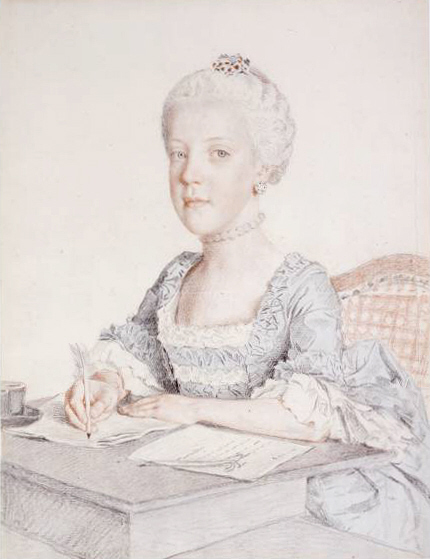
- Born: February 4, 1750 at Hofburg Palace in Vienna, Austria
- Parents: Franz I, Duke of Lorraine, Holy Roman Emperor and Maria Theresa, Archduchess of Austria, Queen of Bohemia, Hungary and Croatia in her own right
- Died: December 23, 1762, aged 12, at Hofburg Palace in Vienna, Austria
- Buried: Imperial Crypt at the Capuchin Church in Vienna, Austria
- Wikipedia: Archduchess Maria Johanna of Austria
Johanna’s older brother Karl Joseph died of smallpox in 1761 and her mother Maria Theresa became a strong supporter of inoculation, as mentioned in the above introduction of this article. In order to set an example, Maria Theresa ordered the inoculation of all her remaining children, hoping it would protect them against smallpox. Unfortunately, Johanna was one of the 3% of those inoculated who developed a serious case of smallpox and died. Johanna’s younger sister Maria Josepha died from smallpox in 1767 despite receiving the inoculation.
********************
Friedrich Christian, Elector of Saxony
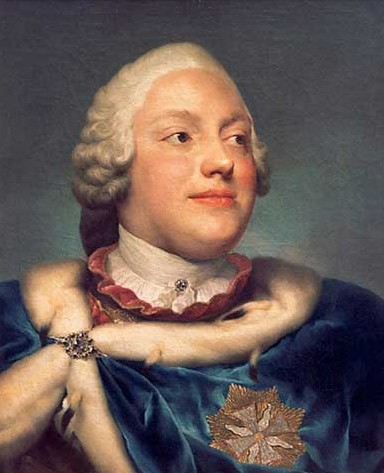
- Born: September 5, 1722 at the Residenzschloss in Dresden, Electorate of Saxony, now in Saxony, Germany
- Parents: Friedrich August II, Elector of Saxony and Maria Josepha of Austria
- Married: Maria Antonia of Bavaria in 1747
- Died: December 17, 1763, aged 41, at the Residenzschloss in Dresden, Electorate of Saxony, now in Saxony, Germany
- Buried: Katholische Hofkirche in Dresden, Electorate of Saxony, now in Saxony, Germany
- Wikipedia: Friedrich Christian, Elector of Saxony
After a reign of only 74 days, Friedrich Christian died from smallpox.
********************
Prince Heinrich of Prussia
- Born: December 30, 1747 in Berlin, Kingdom of Prussia, now in Brandenburg, Germany
- Parents: Prince August Wilhelm of Prussia, son of King Friedrich Wilhelm I of Prussia, and Luise of Brunswick-Wolfenbüttel
- Died: May 26, 1767, aged 19, in Protzen, Kingdom of Prussia, now in Brandenburg, Germany
- Buried: ?
- Wikipedia: Prince Heinrich of Prussia
Heinrich was the nephew of King Friedrich II (the Great) of Prussia who thought his nephew had a promising career in the Prussian army. In May 1767, Heinrich was leading his squadron to Berlin for a parade and review when he stopped at the town Protzen, northwest of Berlin where he caught smallpox and died within several days.
********************
Isabella of Parma, Archduchess of Austria

- Born: December 31, 1741 at Buen Retiro Palace in Madrid, Kingdom of Spain
- Parents: Infante Felipe of Spain, Duke of Parma, Piacenza and Guastalla, and Louise Élisabeth of France
- Married: the future Joseph II, Holy Roman Emperor in 1760 (first wife)
- Died: November 27, 1763, one month and three days before her 22nd birthday, at Hofburg Palace in Vienna, Austria
- Buried: Imperial Crypt at the Capuchin Church in Vienna, Austria
- Unofficial Royalty: Isabella of Parma, Archduchess of Austria
Six months pregnant with her second child, Isabella developed a fever on November 18, 1763, and it soon became clear that she had smallpox. Isabella’s high fever induced labor three months early, and on November 22, 1763, she gave birth to a premature second daughter. The baby was baptized Maria Christina, as Isabella requested, but died the same day. On November 27, 1763, one month and three days before her 22nd birthday, Isabella died from smallpox. Because her body was still infectious, it was buried quickly without an autopsy or embalming.
********************
Maria Josepha of Bavaria, Holy Roman Empress

- Born: March 20, 1739 in Munich, Electorate of Bavaria, now in Bavaria, Germany
- Parents: Karl Albrecht, Elector of Bavaria, the future Holy Roman Emperor Karl VII, and Maria Amalie of Austria
- Married: Joseph II, Holy Roman Emperor in 1765 (2nd wife)
- Died: May 28, 1767, aged 28, at Schönbrunn Palace in Vienna, Austria
- Buried: Imperial Crypt at the Capuchin Church in Vienna, Austria
- Wikipedia: Maria Josepha of Bavaria, Holy Roman Empress
After only two years of marriage, Maria Josepha died of smallpox as had her predecessor Isabella of Parma (see above) . Her husband did not visit her during her illness but her mother-in-law Maria Theresa, Archduchess of Austria, Queen of Bohemia, Hungary and Croatia in her own right, did. In doing so, Maria Theresa also caught smallpox but she survived.
********************
Archduchess Maria Josepha of Austria
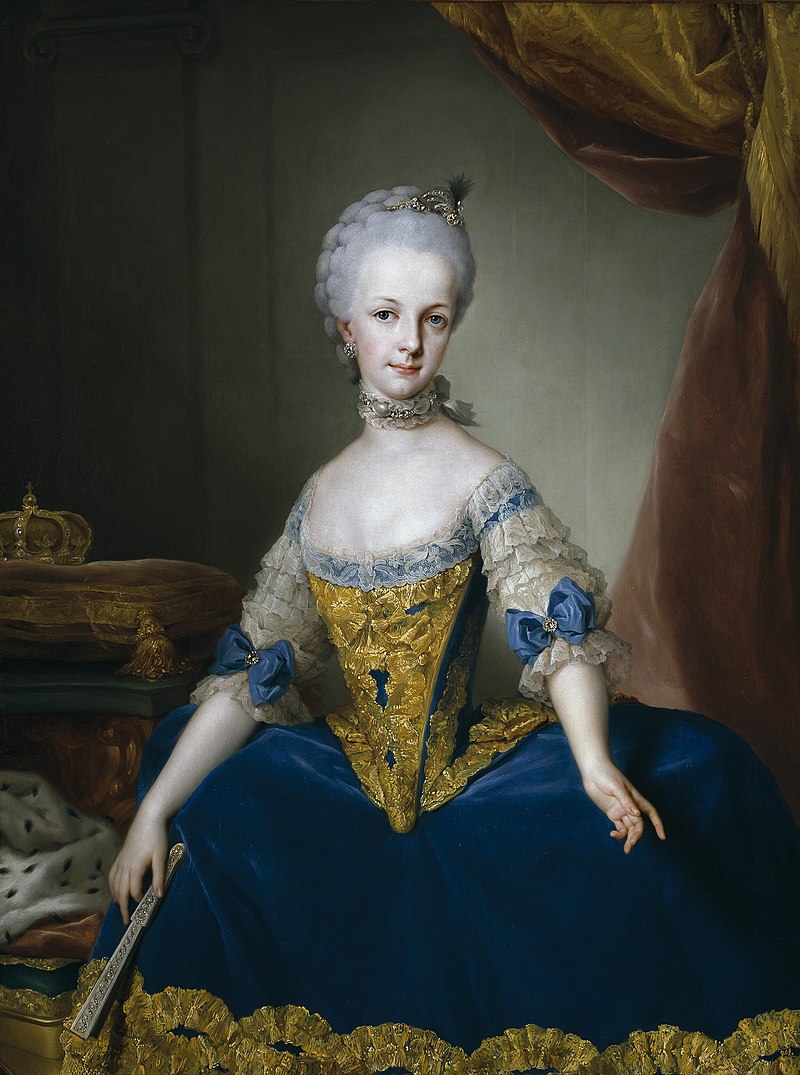
- Born: March 19, 1751 at Hofburg Palace in Vienna, Austria
- Parents: Franz I, Duke of Lorraine, Holy Roman Emperor and Maria Theresa, Archduchess of Austria, Queen of Bohemia, Hungary and Croatia in her own right
- Died: October 15, 1767, aged 16, at Schönbrunn Palace in Vienna, Austria
- Buried: Imperial Crypt at the Capuchin Church in Vienna, Austria
- Wikipedia: Archduchess Maria Josepha of Austria
Maria Josepha’s siblings Carl Josef and Maria Johanna had died of smallpox as had her sister-in-law Maria Josepha of Bavaria, Holy Roman Empress earlier in 1767. She had long been terrified of getting smallpox. Maria Josepha was engaged to marry Ferdinand of Naples and Sicily, the future King of the Two Sicilies, and was preparing to leave Vienna to get married. Before she was to leave Vienna, Maria Josepha made a visit to the Imperial Crypt to pray at the tomb of her sister-in-law Empress Maria Josepha because they shared the same name. Two days later, Maria Josepha came down with smallpox. At the time, there was a popular belief that she caught smallpox because her sister-in-law’s tomb was improperly sealed. This cannot be true because there is an incubation period of about one week before smallpox symptoms appear.
********************
King Louis XV of France
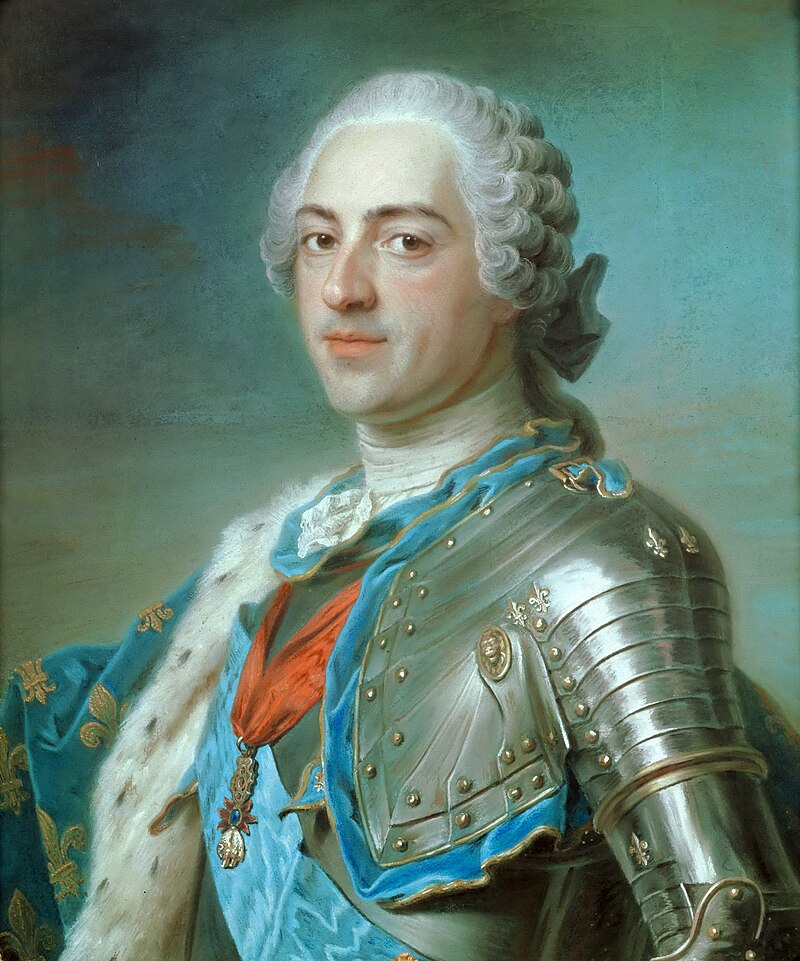
- Born: February 15, 1710 at the Palace of Versailles in Versailles, France
- Parents: Louis, Duke of Burgundy, grandson of King Louis XIV of France, and Marie Adélaïde of Savoy
- Married: Marie Leszczyńska of Poland in 1725, divorced 1768
- Died: May 10, 1774, aged 64, at the Palace of Versailles in Versailles, France
- Buried: Basilica of Saint-Denis near Paris, France
- Unofficial Royalty: King Louis XV of France
Three of Louis XV’s children had died from smallpox and Louis succumbed to the same disease. On April 26, 1774, the symptoms of smallpox appeared while Louis XV was at the Petit Trianon near the Palace of Versailles. He returned to the palace but ordered his heir, his grandson, the future King Louis XVI, and his wife Marie Antoinette to leave the palace because they had not had smallpox. Louis XV was given the last rites on May 7 and died on May 10, 1774.
********************
Princess Caroline of Gloucester
- Born: June 24, 1774 at Gloucester House, Piccadilly Street in London, England
- Parents: Prince William Henry, Duke of Gloucester and Edinburgh and Maria Walpole
- Died: March 14, 1775, aged 8 months, at Gloucester House, Piccadilly Street in London, England
- Buried: St. George’s Chapel, Windsor Castle in Windsor, England
- Wikipedia: Princess Caroline of Gloucester
Caroline’s father was the son of Frederick, Prince of Wales who predeceased his father King George II of Great Britain. Prince William Henry became ill with smallpox and quarantined himself. He wanted to make sure that his children would not suffer from smallpox and so he had them inoculated as described in the introduction to this article above. The inoculation was done on March 3, 1775. Two-year-old Princess Sophia had no side effects from the inoculation. However, Princess Caroline was one of the 3% of those inoculated who developed serious smallpox and she died.
********************
Philip of Naples and Sicily, Duke of Calabria, Infante of Spain
- Born: June 13, 1747 at the Palace of Portici in Portici, Kingdom of Naples, now in Italy
- Parents: King Carlos III of Spain and Maria Amalia of Saxony
- Died: September 19, 1777, aged 30, at the Palace of Portici in Portici, Kingdom of Naples, now in Italy
- Buried: Basilica of Santa Chiara in Naples, Kingdom of Naples, now in Italy
- Wikipedia: Infante Felipe of Spain, Duke of Calabria
Philip was his father’s eldest son and heir but he was excluded from the succession to the thrones of Spain and Naples due to his mental disabilities. When Philip contracted smallpox, his parents fled the palace fearing contagion.
********************
Maximilian III Joseph, Elector of Bavaria

- Born: March 28, 1727 in Munich, Electorate of Bavaria, now in Bavaria, Germany
- Parents: Karl Albrect, Elector of Bavaria, the future Holy Roman Emperor Karl VII, and Maria Amalie of Austria
- Married: Maria Anna Sophia of Saxony in 1747
- Died: December 30, 1777, aged 50, in Munich, Electorate of Bavaria, now in Bavaria, Germany
- Buried: Theatine Church in Munich, Electorate of Bavaria, now in Bavaria, Germany
- Wikipedia: Maximilian III Joseph, Elector of Bavaria
In December 1777, Maximilian became ill but his doctors could diagnose his illness. He was initially treated for measles but by Christmas, it was obvious that he had a virulent strain of smallpox. Maximilian died after three weeks of suffering. He had always rejected the smallpox inoculation for himself (described in the introduction to this article) although he had prescribed for his subjects. Maximilian’s sister Maria Josepha of Bavaria, Holy Roman Empress also died from smallpox.
********************
Children of King Ferdinand IV of Naples and Sicily and Maria Carolina of Austria
Ferdinand and Maria Carolina had sixteen children and seven of them died from smallpox. All were buried at the Church of Santa Chiara in Naples, Kingdom of Naples, now in Italy. They are listed below in death order. Ironically, Maria Carolina of Austria’s sister Maria Josepha of Austria was betrothed to Ferdinand but she died from smallpox right before she was to leave for Naples. Maria Carolina was sent as Ferdinand’s bride instead.
Prince Carlo of Naples and Sicily, Duke of Calabria

Princess Maria Anna of Naples and Sicily

Prince Giuseppe of Naples and Sicily
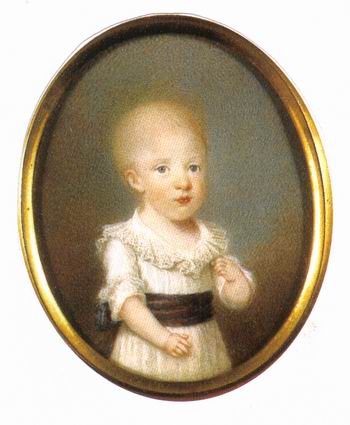
Prince Gennaro of Naples and Sicily

Prince Carlo of Naples and Sicily
- Born: August 26, 1788 at the Royal Palace in Naples, Kingdom of Naples, now in Italy
- Died: February 1, 1789, aged 5 months, at Caserta Palace in the Kingdom of Naples, now in Italy
Princess Maria Clothilde of Naples and Sicily
Princess Maria Enricheta of Naples and Sicily
********************
Prince Alfred of Great Britain

- Born: September 22, 1780 at Windsor Castle in Windsor, England
- Parents: King George III of Great Britain and Charlotte of Mecklenburg-Strelitz
- Died: August 20, 1782, aged 23 months, at Windsor Castle in Windsor, England
- Buried: first at Westminster Abbey in London, England; his remains were moved to St. George’s Chapel, Windsor Castle in 1820, shortly after his father’s death
- Unofficial Royalty: Prince Alfred of Great Britain
In 1782, Alfred received the smallpox inoculation as described in the introduction to this article. He did not recover as he should have, so he was taken to Deal in hopes that the sea air and saltwater would help. However, the air and water did not help. Alfred’s face and his eyelids had smallpox eruptions and he had difficulty with breathing. There was not much improvement when Alfred returned to Windsor Castle. The doctors agreed that he would survive for only a few weeks more which came as a great shock to his family. After suffering from prolonged bouts of fever, Alfred died, a month short of his second birthday.
********************
Princess Maria Carolina of Savoy, Electoral Princess of Savoy

- Born: November 17, 1764 at the Royal Palace of Turin in Turin
- Parents: King Vittorio Amedeo III of Sardinia and Maria Antonietta of Spain
- Married: Anton, Electoral Prince of Saxony in 1781
- Died: December 28, 1782, aged 18, in Dresden, Electorate of Saxony, now in Saxony, Germany
- Buried: Katholische Hofkirche in Dresden, Electorate of Saxony, now in Saxony, Germany
- Wikipedia: Maria Carolina of Savoy, Electoral Princess of Savoy
Married in 1781, Maria Carolina did not leave for Saxony until September 1782. She was reluctant to leave her home. In Saxony, her husband and his brother did their best to make her feel welcome but Maria Carolina was homesick. Two months later, she died from smallpox.
********************
Prince Octavius of Great Britain

- Born: February 23, 1779, at the Queen’s House (now Buckingham Palace) in London, England
- Parents: King George III of the United Kingdom and Charlotte of Mecklenburg- Strelitz
- Died: May 3, 1783, aged four, at Kew Palace in London, England
- Buried: first at Westminster Abbey in London, England; his remains were moved to St. George’s Chapel, Windsor Castle in 1820, shortly after his father’s death
- Unofficial Royalty: Prince Octavius of Great Britain
In 1783, Octavius and his sister Sophia had their smallpox inoculations as described in the introduction above. Sophia recovered without incident, but four-year-old Octavius became ill with a serious case of smallpox and died several days later. King George III was heartbroken and said, “There will be no heaven for me, if Octavius is not there.”
********************
José, Prince of Brazil, Duke of Braganza

- Born: August 20, 1761 at the Real Barraca in Ajuda, Portugal
- Parents: Infante Pedro of Portugal (King Pedro II of Portugal) and Queen Maria I of Portugal
- Married: Infanta Benedita of Portugal in 1777
- Died: 11 September 11, 1788, aged 27, at the Real Barraca in Ajuda, Portugal
- Buried: Monastery of São Vicente de Fora in Lisbon, Portugal
- Wikipedia: Prince José of Brazil, Duke of Braganza
José was his parents’ eldest child and heir to the throne of Portugal. His death from smallpox greatly distressed his wife and mother. His sister Mariana Victoria (below) also died from smallpox less than two months later.
********************
Infanta Mariana Victoria of Portugal, Infanta of Spain

- Born: December 15, 1768 at the Royal Palace of Queluz in Lisbon, Portugal
- Parents: Parents: Infante Pedro of Portugal (King Pedro II of Portugal) and Queen Maria I of Portugal
- Married: Infante Gabriel of Spain in 1785
- Died: November 2, 1788, aged 19, at Casita del Infante in El Escorial, Spain
- Buried: Monastery of San Lorenzo of El Escorial in El Escorial, Spain
- Wikipedia: Infanta Mariana Victoria of Portugal, Infanta of Spain
Mariana Victoria gave birth to her third child on October 28, 1788, and died from smallpox five days later. It is possible that she was already ill with smallpox when she gave birth. Her newborn son Infante Carlos of Spain died from smallpox on November 9, 1788. Mariana Victoria’s husband also died from smallpox. (See below)
********************
Infante Gabriel of Spain

- Born: May 12, 1752 at the Palace of Portici in Naples, Kingdom of Naples
- Parents: King Carlos III of Spain and Maria Amalia of Saxony
- Married: Infanta Mariana Victoria of Portugal
- Died: November 23, 1788, aged 36, at Casita del Infante in El Escorial, Spain
- Buried: Monastery of San Lorenzo of El Escorial in El Escorial, Spain
- Wikipedia Infante Gabriel of Spain
Gabriel’s wife Mariana Victoria (above) gave birth to her third child on October 28, 1788, and died from smallpox five days later. Their newborn son Infante Carlos of Spain died from smallpox on November 9, 1788. Two weeks later, Gabriel also died from smallpox, leaving his only surviving child Infante Pedro Carlos of Spain an orphan. Pedro Carlos was raised by his maternal grandmother Queen Maria I of Portugal who made him an Infante of Portugal.
********************
This article is the intellectual property of Unofficial Royalty and is NOT TO BE COPIED, EDITED, OR POSTED IN ANY FORM ON ANOTHER WEBSITE under any circumstances. It is permissible to use a link that directs to Unofficial Royalty.


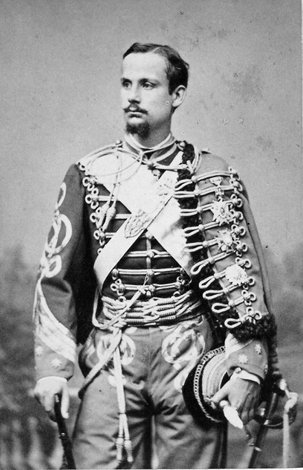





























 Louis, Hereditary Prince of Lorraine
Louis, Hereditary Prince of Lorraine





























